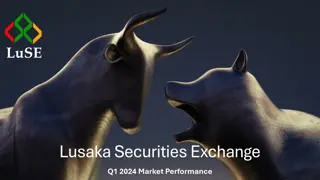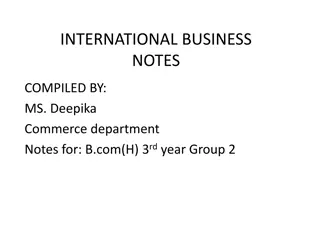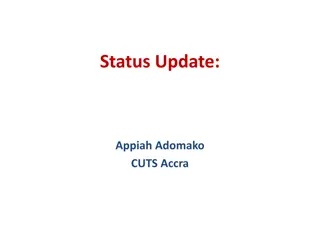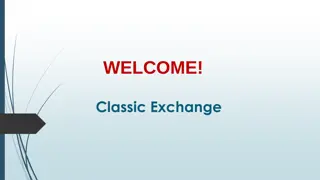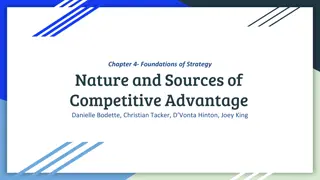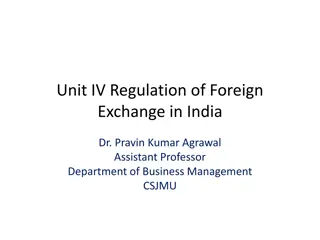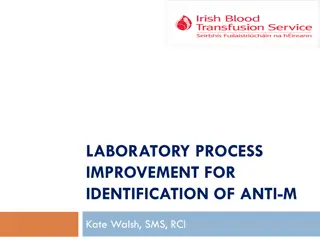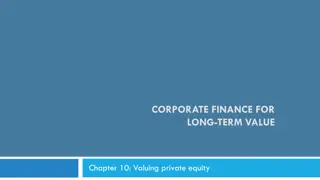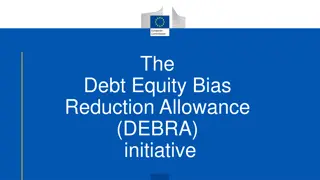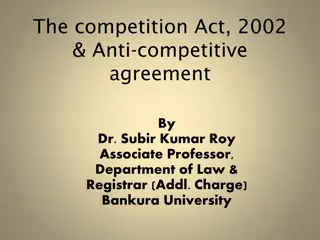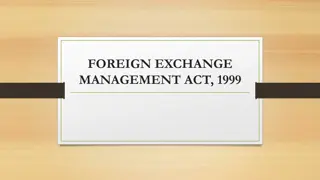Analysing Equity Market Exchange Structure for Anti-Competitive Practices
The discussion by Chester Spatt from Tepper School, Carnegie Mellon, delves into the intricacies of equity market exchange structures and their potential anti-competitive nature. Various topics such as post-NMS trading, exchange access fees, market data debates, and the agency problem arising from pricing tiers and rebate structures are explored. Insights are provided on the implications of exchange costs, pricing models, agency conflicts, and the distinction between maker-taker and taker-maker models. Additionally, the concept of cross-subsidization and the need for improved disclosures in trading practices are highlighted.
Download Presentation

Please find below an Image/Link to download the presentation.
The content on the website is provided AS IS for your information and personal use only. It may not be sold, licensed, or shared on other websites without obtaining consent from the author. Download presentation by click this link. If you encounter any issues during the download, it is possible that the publisher has removed the file from their server.
E N D
Presentation Transcript
Is Equity Market Exchange Structure Anti-Competitive? By Chester Spatt Tepper School, Carnegie Mellon The Microstructure Exchange virtual seminar June 9, 2020
Post NMS Trading, Exchanges Access fee pilot & market data debate Affiliate families vs. competition Cross-subsidization Analogy: Pricing tiers: The design of airline frequent flyer programs and competition Rebate pricing tiers: Customized, intricate, price discrimination (not cost) & agency Interaction: Pricing tiers, data, co-location Profit-max pricing tactics by exchanges Best Execution, discrimination, disclosure 2
Theoretical Insights If exchange costs depend upon total number of trades, messages and shares executed (but not the distribution) and relationships, then rebate tiers for individual customers reflect only demand discrimination and not costs Price tiering enhances agency conflict compared to constant make-take prices. That many of largest liquidity providers have negative all-in pricing implies agency 3
Conceptual Insights Incentive to subsidize trade reflects larger value of data & co-location sold to others Cross-subsidization (between pricing and data/connectivity) leads to a more sophisticated approach of quantity discounting, compared to traditional price discrimination (where larger users are charged higher prices!) Non-prescriptive approach to Best Execution to facilitate evolving standards 4
Maker-taker vs. Taker-maker Maker-taker Subsidize maker (limit order) rebate Charge fees to taker (market order) Encourage liquidity provision: Exchange comp Taker-maker ( inverted model ) Subsidize taker (market order) rebate Charge fees to maker (limit order) Enhance market orders Similarities to payment for order flow model Neutrality vs. Agency (Routing distorted?) 5
Agency Problem Distortion in the routing decision due to distinct buckets for routing fees & rebates vs. execution sets up agency conflicts Evidence in the form of routing to platforms that offer rebates, poor/slow execution both equilibrium, agency Battalio, Corwin and Jennings (JF, 2016) documents agency problems & identifies some problematic brokers (retail) Enhanced disclosures on routing practices or execution costs would be very useful Ban on fees/rebates or side pocket 6
Access Pilot Proposal SEC unanimously adopted (Dec. 2018) a pilot to study tightening the fee caps and whether it should ban rebates Control and three treatment groups Reduce fee cap to 15 mils from 30 mils Reduce fee cap to 5 mils from 30 mils Eliminate rebates and let fees adjust Exchanges filed suit vs. SEC Agency vs. neutrality revisited Partial stay by SEC, pending resolution 7
Recent SEC Action on Market Data SEC (10/16/2018) declared that it would only approve proposed exchange price increases satisfying Exchange Act Fair and reasonable; not unduly discriminatory; promote competition Public roundtable (10/25-26/2018) highlighted calls for the exchanges to be more transparent to facilitate compliance Exchanges vs. buy-side & brokers D.C. Circuit (on Friday): SEC lacked authority after not suspending (60 days) 8
Exchanges and Affiliates Three main exchange families (95% share) and many exchanges NYSE (five) Nasdaq (three) BATS/CBOE (BATS & Direct Edge merger--4) IEX (no rebates) new entrant, no price tiering and data charges Emerging exchanges--e.g., LTSE, MMEX Joint staffing, potential pricing coordination within a parent company/family 9
Nature of Competition Tension between competition for individual orders (better pricing for customers) vs. competition among platforms (innovation) Issue in selling assets (e.g., house brokers) Central limit order book ( CLOB ) and the importance of liquidity externality vs. fragmentation Affiliate families limit the competition among platforms in pricing exchange activities without concentrating liquidity & enhancing the competition facing orders 10
Rebates and Fees Fees are capped at 30 mils/shares (Reg NMS) Baseline rebates at about 20 mils/share Rebates increase with activity (price tiers) Average about 25 mils/share Many alternatives to get somewhat larger rebates, sometimes larger than 30 mils Given that costly to operate a trading platform, fees should exceed rebates, at least without cross-subsidization Otherwise, access fees are a loss leader 11
Cross Subsidization of Trading In a number of situations the highest rebates being offered can exceed the maximum fee (30 mils) under Reg NMS Nasdaq: 30.5 Direct Edge: 32 BATS: 32 ARCA: 31 (NYSE: 27.5 mils) NYSE American with Electronic DMM: 45 mils to add displayed liquidity (and charge only two mils to take liquidity!) 12
Frequent Flyer Programs Former expert ; no flights since 3/6/20 Major airlines (American, United, Delta) used four award levels and two main paths to get to each: Each airline had 8 pricing tiers & more options Limited options to buy miles or status opaque customization surplus extraction All paths involve qualifying dollar spending & either qualifying miles or segments American and United used identical thresholds; Delta mostly used similar ones 13
More on Frequent Flyer Status Many paths facilitate price discrimination & surplus extraction (Qualifying dollars, miles or segments can bind) Average reward increases with flights Entry barrier vs. entrants whose rewards & benefits essentially proportional: JetBlue, Southwest Status based on cumulative performance Marginal value uncertain early in the period Marginal value high (or low) late in the period 14
Large Numbers of Pricing Tiers Per Royal Bank of Canada (RBC) Capital Market, 1,023 pricing tiers across platforms (839 two years ago) The pricing tiers determined by at least 3,762 pricing variables Of these, 381 consist of rebates 15
Pricing Tiers and Complexity Odd ( weird ) features to some pricing tiers together with the number of them suggests that many selected by a single participant or designed for one extraction and price discrimination; customization Many tiers with complex conditions some very odd as if customized for some clients (and to exclude others): RBC, 2018 Price discrimination vs. cost conclusion Relatively continuous rebates differ only by about .5 mils, but increasing w/activity 16
Table 1 (Nasdaq) Rebate to Add Displayed Liquidity Conditions: All US Equities (Executed at or above $1.00 per share) Rebate for Per Share Executed Greater than 1.25% add Greater than 0.60% added Greater than 0.30% added Greater than 0.10% added Minimum of 250,000 shares added per day in Tape A or Tape B securities (combined) Minimum of 10,000 shares executed via QDRK $0.00305 $0.0029 $0.0027 $0.0025 $0.0020 $0.0020 $0.0020 for Tape A & B Securities $0.0015 for Tape C Securities All other firms [
Table 2 (Nasdaq) Rebate to Add Displayed Liquidity Conditions: All US Equities Rebate for Per Share Executed (Executed at or above $1.00 per share) 1. Add greater than 0.60% TCV; and 2. Add NOM Market Maker liquidity in Penny Pilot Options and/or Non- Penny Pilot Options of 0.10% or more of total industry ADV in the customer clearing range for Equity and ETF option contracts per day in a month on NOM; and $0.00305 3. Add Customer, Professional, Firm, Non-NOM Market Maker and/or Broker-Dealer liquidity in Penny Pilot Options and/or Non- Penny Pilot Options of 1.50% or more of total industry ADV in the customer clearing range for Equity and ETF option contracts per day in a month on NOM Add greater than 0.12% TCV; and 1. 2. Add Customer, Professional, Firm, Non-NOM Market Maker and/or Broker-Dealer liquidity in Penny Pilot Options and/or Non-Penny Pilot Options of 1.15% or more of total industry ADV in the customer clearing range for Equity and ETF option contracts per day in a month on NOM $0.0030 1. Add greater than 0.10% TCV; and 2. Add Customer, Professional, Firm, Non-NOM Market Maker and/or Broker-Dealer liquidity in Non- Penny Pilot Options of 0.40% or more of total industry ADV in the customer clearing range for Equity and ETF option contracts per day in a month on NOM $0.0027
Table 4 (Nasdaq) Rebate to Add Displayed Liquidity Conditions: All US Equities (Executed at or above $1.00 per share) Greater than 0.60% added Greater than 0.40% added of which 0.10% are Tape B securities Greater than 0.15% added and total contracts per day (added and removed) of 0.9% or more of total industry ADV in the customer clearing range for Equity and ETF option contracts per day in a month on NOM Rebate for Per Share Executed $0.0029 $0.0029 $0.0029 Add greater than 0.50% TCV and Remove greater than 0.70% TCV Add Customer, Professional, Firm, Non-NOM Market Maker and/or Broker-Dealer liquidity in Penny Pilot Options and/or Non- Penny Pilot Options of 1.15% or more of total industry ADV in the customer clearing range for Equity and ETF option contracts per day in a month on NOM $0.0029 $0.0029
Monthly Tiers Tier price applies to the current month, but only known at the end of the month This prevents the broker from immediately rebating back the rebate to his client or even disclosing it contemporaneously, which would have been natural solutions to agency problem. Clients (buy-side) recognize the inability to rebate or disclose contemporaneously 20
Monthly Tiers, Agency Conflicts Lack of knowledge of incentive by buy- side client prevents neutralizing Exchange interest served by agency conflict as it maximizes the broker s incentive otherwise no ability to price discriminate or serve as entry barrier Constant tiers would mitigate some of the agency conflict as rebate would be known Cost economies at market, not firm level! Exchange s client is the broker-dealer; exchange doesn t know investor identity 21
Partial Remedies Public disclosure of pricing tiers by exchanges under SEC s fair access requirements However, no public disclosure of which pricing tier a particular broker received Even no disclosure of number of brokers using a specific tier--could alter behavior Enhance disclosure setting, IAC statement Suggest banning non-constant rebates, if rebates retained (Congressional letter cites small brokers) 22
Why Cross Subsidize? Over time relatively more of the revenue of the NYSE and Nasdaq comes from selling data and relatively less from trading A reasonable assumption is that the value of data is proportional to overall trading activity, so subsidizing trading can be profitable Price discrimination as a form of cross subsidization when costs reflect total number of executions, shares and message but not the distribution 23
More on Cross Subsidization Ordinarily, cross subsidization is fine when there are two-sided markets (platform theory). However: Agency theory potentially important distortions in trading and order routing link to price tiering Exchange Act pricing Fair and reasonable; not unduly discriminatory; promote competition IEX recently did its own cost study to argue costs are about 5% of data/connectivity fees 24
Data as a Product Potential costs (technology) now quite low Whose data (intellectual property?) is it? Zuckerberg say data not owned by Facebook! Basic quotes and trade data are utility, SIP Exchanges offer a range of prop data (e.g., order books) & co-location services Of course, some potential purchasers of proprietary data would find the value much greater than others--e.g. high volume, HFT Data, co-location fees fixed, so does not discourage activity not trad. price discrim 25
Rebates and Trading Incentives Rebate tiering and marginal incentives increases activity on an exchange and value of its proprietary data & co-location Higher (marginal) rebates imply that the value of being at the front of the queue is greater Hence greater incentive to achieve this and hence willingness to purchase fast technology and co-location to become as fast as possible Akin to the dynamic between trading and data Strong interaction effects 26
Profit Max by Exchanges Attract activity by fixed fees for proprietary and co-location (costs, but no variable charges); reinforced by volume discounts for orders adding liquidity (tiered rebates) Facilitates price discrimination to individual brokers due to diminishing marginal cost Price discrimination reinforced across volume states by using relative volumes By attracting more orders, exchanges charge more for prop data & co-location Large liquidity providers: Neg all-in pricing 27
Best Execution If proprietary data is required for Best Execution, then the Exchanges would charge relatively higher prices for data as monopolist. Monopoly arises due to the business need for data, even w/o Best Ex Value of prop data reinforces value of data across markets (Glosten, 2020) While investors can execute anywhere--so little monopoly power in stock prices, each exchange has monopoly control over data! So more important to regulate data pricing than stock prices; Opp. of prior SEC (& NMS) 28
More on Best Execution U.S. Treasury Capital Markets report suggests not requiring data for Best Execution, except for the basic data through the SIP for Best Execution Purchase of proprietary data viewed as a regulatory cost & source of market power SEC not explicit about what data needed for Best Ex perhaps because of faster markets, evolving algos this allows regulations to evolve with technology 29
Conclusions Price discrimination and marginal reward not cost driven Customization and surplus extraction Relative volume entry barrier for exchange and brokerage customers (brokers can aggregate orders) Agency maximizes routing incentive Tiering prevents neutralizing agency Tiering enhances value of data, colocation Increasing rebates, not traditional discrim. Policy: Strong disclosure, constant rebates 30



